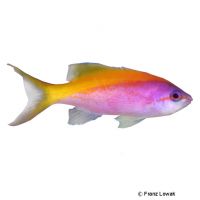Yellowback Anthias (Pseudanthias evansi)
| Yellowback Anthias Pseudanthias evansi | |
|---|---|
| Name | Yellowback Anthias |
| Name Lat. | Pseudanthias evansi |
| Synonym | Mirolabrichthys evansi |
| Family | Sea Basses |
| Family lat. | Serranidae |
| Order | Perch-likes |
| Order lat. | Perciformes |
| Origin | Indian Ocean |
| Habitat | Seaward reefs |
| Diet | Planktivore |
| pH | 8.1-8.4 |
| Hardness | 8-10 °KH |
| Behavior | Semi-aggressive |
| Keeping | Group |
| Reef Compatible | Yes |
| Care Level | Difficult |
| Life Span | 3-5 years |
| Protection | No |
| Metric Units | |
| Size | 10 cm |
| Temperature | 24-28 °C |
| Salinity | 33-36 ‰ |
| Aquarium | ~ 400 l |
| US Units | |
| Size | 4" |
| Temperature | 75-82 °F |
| Salinity | 1.020-1.025 sg |
| Aquarium | ~ 100 gal |
Distribution and habitat
The distribution area of Pseudanthias evansi is the Indian Ocean, from the East African coast over the Andaman Sea and the Christmas Islands to the Cocos Islands. There they live in shoals on the slopes of lagoon reefs up to 40 m depth.
Maintenance
They require a well-structured aquarium with a reef structure (many crevices and caves) and with live stones that act like a biological filter, as well as plenty of swimming space with a steady current. Only lime-rich, heavy metal-free sands, gravels, stones or sea sand of various grain sizes may be used as substrate
Filters, skimmers and heaters are necessary to ensure water quality, as well as pumps to simulate tides, swells and bottom currents. Lighting must correspond to the species-appropriate day-night rhythm of the animals
| Salinity: 33-36 ‰ | pH value: 8.1-8.4 |
| Carbonate hardness: 8-10 °KH | Nitrate content: 2-8 mg/l |
| phosphate content: 0.01-0.1 mg/l | nitrite content: 0.0-0.05 mg/l |
For salinity, an average value should be aimed for, which may only vary slightly by +/- 0.5 ‰. Ammonia and ammonium must not be measurable. Special attention must be paid to consistently good water quality and water values.
Diet
They are permanent feeders, feeding mainly on zooplankton and suspended algae. The food change does not always succeed without problems. The food supply should consist of a combination of live and frozen food, such as small mysis, krill, fish roe, lobster eggs, artemia, cyclops and bosmids, or a commercially available frozen special food mixture enriched with vitamins for plankton eaters. Dry food (granules, flakes) is rarely accepted
It is recommended to feed small portions several times a day (5-8 times). Regular and varied feeding promotes health and increases resistance.
Behaviour and compatibility
They should be kept in a group of at least 6 animals. To avoid ranking fights, one group should be introduced into the aquarium at a time. They have a highly specialized social behavior, skirmishes with short chases are normal (hiding places). Care should be taken when socializing with surgeonfish and red colored wrasses are often not tolerated. They usually behave peacefully towards other fish.
Sex dimorphism
They are protogynous hermaphrodites, i.e. males develop from functional females when needed. There are no known external distinguishing characteristics.
Reproduction and breeding
There are no known reports of successful breeding in the aquarium.
Important
In case of danger they disappear in a flash into coral and rock crevices. A weak night light is advantageous, as they tend to jump out of the aquarium in complete darkness
It is recommended to keep these typical reef inhabitants together with corals and not to keep them in a fish-only aquarium.
If different species are kept together, make sure that the fish match each other in terms of water quality and temperature requirements as well as their social behavior, and that the setup meets the needs of all species kept together. Newly introduced fish must be acclimated slowly to the water in the aquarium
Further literature can be found in your pet store.
References
Text: Werner Winter; Image: Franz Lowak
Source: KUITER & DEBELIUS (2007): Atlas der Meeresfische: Die Fische an den Küsten der Weltmeere, Kosmos Verlag; BAENSCH & DEBELIUS (2006): Meerwasser Atlas Bd. 1, Mergus Verlag; ENGELMANN (2005): Zootierhaltung - Tiere in menschlicher Obhut: Fische, Verlag Harri Deutsch
- Gemäß § 21 Abs. 5 Tierschutzgesetz idgF
